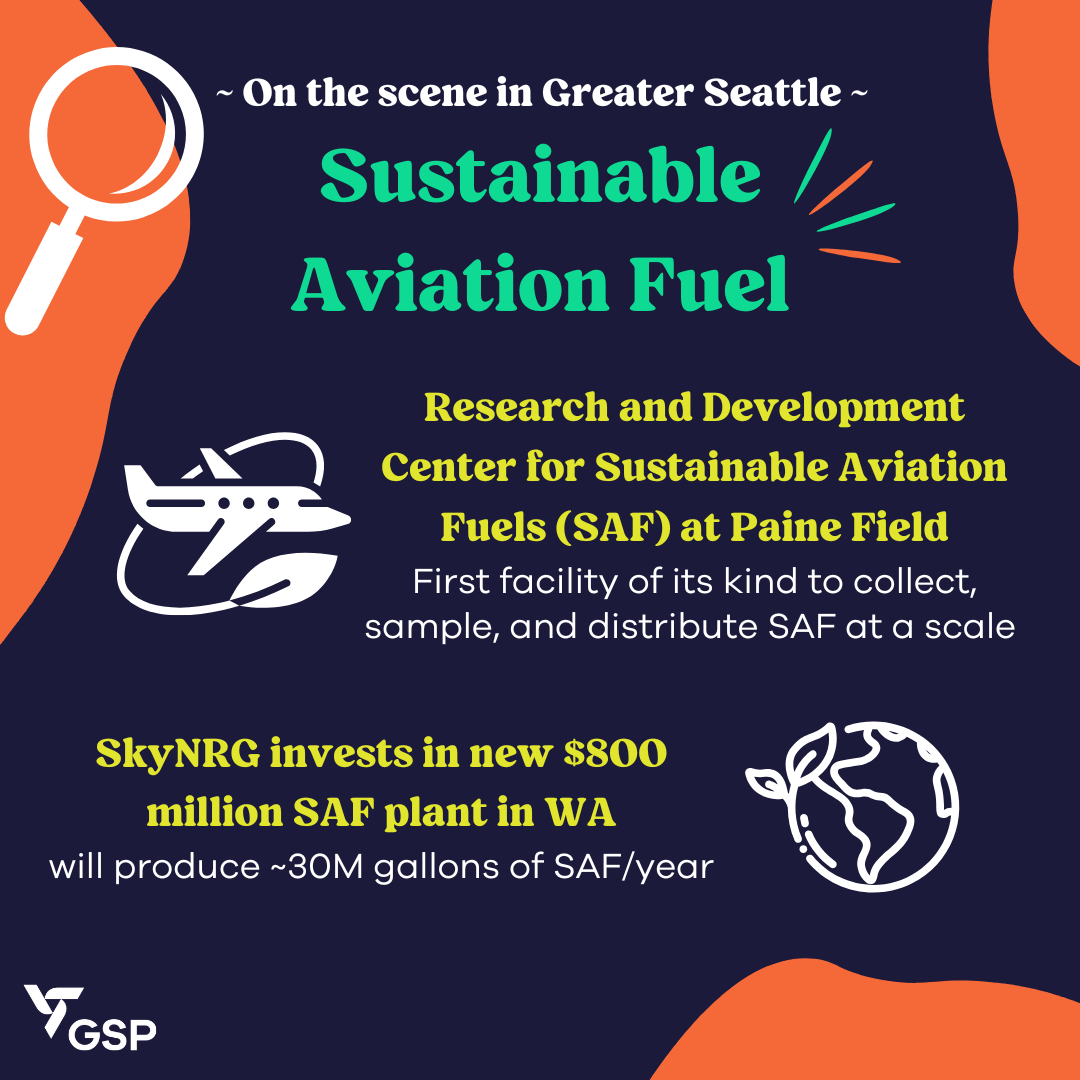Investing in Sustainable Aviation Fuel: Washington State’s Clean Energy Takeoff
As the global aviation sector accelerates efforts to decarbonize, Sustainable Aviation Fuels (SAF) have emerged as a critical tool in achieving net-zero emissions targets. With deep roots in aerospace innovation and a thriving clean tech ecosystem, Washington state is one of the leaders in the nation in advancing SAF technologies, infrastructure, and investment.
What is SAF and Why Does It Matter?
SAF is a renewable alternative to traditional jet fuel, made from non-petroleum feedstocks such as used cooking oil, agricultural waste, algae, and even captured carbon. When blended with conventional Jet A or Jet A-1 fuel (typically at levels between 10% and 50%, depending on the specific SAF and regulatory approvals), SAF can reduce lifecycle greenhouse gas emissions by up to 80%, without requiring modifications to current aircraft engines or airport fueling systems. This drop-in compatibility makes SAF a scalable and immediate solution for sustainable air travel.
What is SAF Made Of? The Diverse Feedstock Landscape
While SAF is increasingly being integrated into existing airport fuel supply chains, dedicated “SAF hubs” emerge as strategic locations for production, blending, storage, and distribution. The “sustainable” in SAF refers to the renewable nature of its source materials. SAF can be produced from a wide array of feedstocks through various technological pathways:
- Used Cooking Oil and Animal Fats (HEFA Pathway): Hydroprocessed Esters and Fatty Acids (HEFA) are currently the most mature and widely used pathway. This involves refining waste oils, greases, and animal fats.
- Agricultural and Forestry Residues: Waste products from farming (like crop residues and forestry residues) and forestry operations can be converted into SAF.
- Municipal Solid Waste (MSW): Non-recyclable household and commercial waste, including food scraps, yard waste, and packaging materials, can be transformed into jet fuel, diverting waste from landfills.
- Algae: Certain types of algae can be cultivated and processed to produce biofuels suitable for aviation.
- Purpose-Grown Energy Crops: Non-food crops grown on marginal lands can be used as dedicated feedstocks for SAF.
- Alcohol-to-Jet (AtJ): This pathway converts alcohols, such as ethanol (derived from corn, sugarcane, or cellulosic biomass) or isobutanol, into jet fuel.
- Power-to-Liquid (PtL) or eFuels: A newer and promising technology that involves synthesizing captured carbon dioxide (from industrial sources or direct air capture) with green hydrogen (produced using renewable electricity) to create synthetic liquid hydrocarbons.
The choice of feedstock and production technology significantly influences the overall carbon reduction potential of the SAF.
How Do SAF Hubs Work?
SAF hubs function as nexuses in the SAF supply chain:
- Feedstock Sourcing: Hubs are often strategically located near sources of viable feedstock or with good transportation links to receive them.
- Production: Dedicated refineries or retrofitted conventional refineries utilize various approved technologies (HEFA, AtJ, PtL, etc.) to convert feedstocks into SAF.
- Blending: The neat SAF (“neat SAF” refers to 100% sustainable aviation fuel that is not blended with conventional jet fuel) is then blended with conventional jet fuel to meet current certification standards (e.g., up to a 50% blend).
- Storage and Distribution: The blended SAF is stored and then distributed to airports through existing pipelines, tankers, or dedicated fueling infrastructure.
- “Book and Claim” Systems: Many regions also utilize “book and claim” systems. This allows an airline or corporation to purchase SAF certificates (SAFc) representing the environmental benefits of a certain volume of SAF, even if the physical fuel is not delivered to their specific location. The actual SAF is used by an aircraft operator at an airport where it is physically available. This system helps aggregate demand, fund SAF production, and allows entities to meet their emission reduction goals regardless of their geographical proximity to SAF supply.
Washington State: A National Leader in SAF Innovation
From cutting-edge research labs to first-of-their-kind production facilities, Washington is home to a growing ecosystem of SAF pioneers. Here are key players driving this momentum:
Washington State University’s SOAR Lab (Tri-Cities)
WSU’s Sustainable Options for Aviation Research Lab offers North America’s most advanced SAF testing capabilities. Partnering with over 35 institutions, SOAR is central to fuel performance validation and supports the FAA’s ASCENT Center of Excellence.
Learn more
The SAF Center at Paine Field (Everett)
A new hub backed by Boeing, Alaska Airlines, Snohomish County, and WSU, this facility will manage SAF sample repositories, performance research, and commercial scale blending for validation and scaling.
Learn more
bp America’s Cherry Point Refinery (Blaine)
In August 2024, the FAA announced that bp Cherry Point was awarded a $26,763,504 FAST SAF grant to build infrastructure and buy equipment to allow them to produce sustainable aviation fuel for the first time, using renewable biomass feedstocks. bp estimates being able to produce 10 million gallons of SAF per year.
Learn more
SkyNRG Americas – Project Wigeon (Walla Walla)
Global SAF leader SkyNRG is building its first U.S. production site in Eastern Washington. With projected capacity of 50M gallons/year of SAF and renewable diesel, the facility is expected to bring 100+ permanent jobs and 600 construction jobs.
Learn more
Twelve – E-Jet Plant (Moses Lake)
This Bay Area-based climate-tech startup is investing in a novel facility in central Washington to produce eFuels using green hydrogen and captured CO₂. Powered by local hydropower, the plant marks a significant advance in electrofuel commercialization.
Learn more
Port of Seattle (SEA Airport)
A national SAF policy trailblazer, SEA Airport is targeting 10% SAF blend by 2028. The Port supports Washington’s Clean Fuel Standard and has launched studies with Boeing, Alaska Airlines, and King County to integrate SAF into fueling infrastructure.
Learn more
Sustainable Aviation Fuels Northwest (SAFN)
A multi-stakeholder coalition including Boeing, Alaska Airlines, WSU, the Port of Seattle, and others, SAFN is focused on regional feedstock analysis, public-private coordination, and accelerating SAF adoption across the Pacific Northwest.
Learn more
In December 2024 the Washington Alternative Jet Fuels Work Group submitted the report “Sustainable Aviation Fuel Updates and Recommendations: Opportunities for Washington” to the Washington Legislature. The Washington Alternative Jet Fuels Work Group made 5 recommendations for consideration. In 2025 and 2026 the Work Group will develop new recommendations for 2026 and develop a deeper understanding of book and claim methods for Alternative Jet Fuel and examine the potential of incentives for co-products went alternative jet fuel is produced. Learn more

Economic Development Through Clean Aviation
SAF market is projected to exceed $6.9 billion in the U.S. by 2030. With Greater Seattle’s aerospace supply chain, skilled talent, and abundant clean energy, the region is uniquely positioned to capture a significant share of that market. SAF innovation is already spurring job creation, attracting international investment, and strengthening our region’s leadership in next-generation fuels. These efforts support both metro and rural communities, from Moses Lake to Walla Walla to the Puget Sound.
Incentives: Fueling the Growth of SAF
Federal programs such as the Sustainable Aviation Fuel Grand Challenge aim to produce 3 billion gallons of SAF annually by 2030. Washington’s policy leadership, including state tax incentives up to $2/gallon, complements the national framework, creating fertile ground for SAF innovation and commercialization.
Tax Credits: The U.S. Inflation Reduction Act (IRA) of 2022 introduced a significant tax credit for SAF, starting at $1.25 per gallon for fuels achieving a 50% lifecycle GHG reduction, with an additional $0.01 for each percentage point of reduction beyond 50%, up to a maximum of $1.75 per gallon (or $0.50 bonus). Several U.S. states, like Minnesota and California (through its Low Carbon Fuel Standard – LCFS), also offer incentives.
Grants and Loan Guarantees: Governments are providing grants and loan guarantees for the research, development, and construction of SAF production facilities. For example, the U.S. Department of Energy has provided loan guarantees to SAF producers like Gevo.
Public-Private Partnerships: Initiatives like the U.S. Sustainable Aviation Fuel Grand Challenge aim to accelerate SAF development through collaboration between government agencies and industry stakeholders, targeting 3 billion gallons of domestic SAF production per year by 2030 and 35 billion gallons by 2050.
Airport-Led Initiatives: The Port of Seattle was the first United States airport operator to set a specific timetable and goals for transitioning all airlines at SEA to commercially competitive sustainable aviation fuels. The first goal is to power every flight fueled at SEA with at least a 10% blend of sustainable aviation fuel (SAF) by 2028.
Investment Landscape: Who is Investing in SAF?
Significant investments are flowing into the SAF sector from a diverse range of players:
Airlines: Major carriers such as United Airlines, Delta Air Lines, Air France-KLM, British Airways (IAG), Qantas, American Airlines, and Alaska Airlines are making substantial investments in SAF through direct procurement agreements, equity stakes in SAF producers, and partnerships to develop new production facilities.
Energy Companies: Traditional oil and gas giants like Shell, Neste, TotalEnergies, and ExxonMobil are leveraging their refining expertise and infrastructure to become major SAF producers. They are investing in new facilities and retrofitting existing ones.
Specialized Biofuel Companies: Dedicated SAF producers and developers like Gevo, World Energy, Fulcrum BioEnergy, and LanzaTech are attracting significant capital to scale up their innovative production technologies.
Private Equity and Infrastructure Investors: Firms such as Bain Capital (investing in EcoCeres) and Brookfield Asset Management (investing in Infinium) recognize the long-term potential of SAF and are injecting substantial capital into SAF projects and infrastructure.
Aircraft and Engine Manufacturers: Companies like Boeing and Airbus are actively involved in SAF development, testing, and investing in SAF initiatives to ensure compatibility and promote adoption. Honeywell is also a key technology provider and investor.
Governments: Beyond incentives, governments are directly investing in research and development and providing financial backing for pioneering SAF projects.
The World Economic Forum highlights the need for an estimated $19-45 billion in capital expenditure by 2030 to meet SAF production demands.
The Path Forward
Sustainable Aviation Fuels are a cornerstone of the aviation industry’s strategy to achieve net-zero carbon emissions by the mid-century. While challenges remain, particularly concerning cost competitiveness, feedstock availability, and the scaling up of production, the momentum is undeniable. Continued technological innovation, supportive government policies, sustained investment, and cross-industry collaboration will be essential to unlock the full potential of SAF and pave the way for a more sustainable future for air travel.
Requirements for Sustainable Aviation Fuel Financing | ICF

Ready to take advantage of everything Greater Seattle has to offer?
